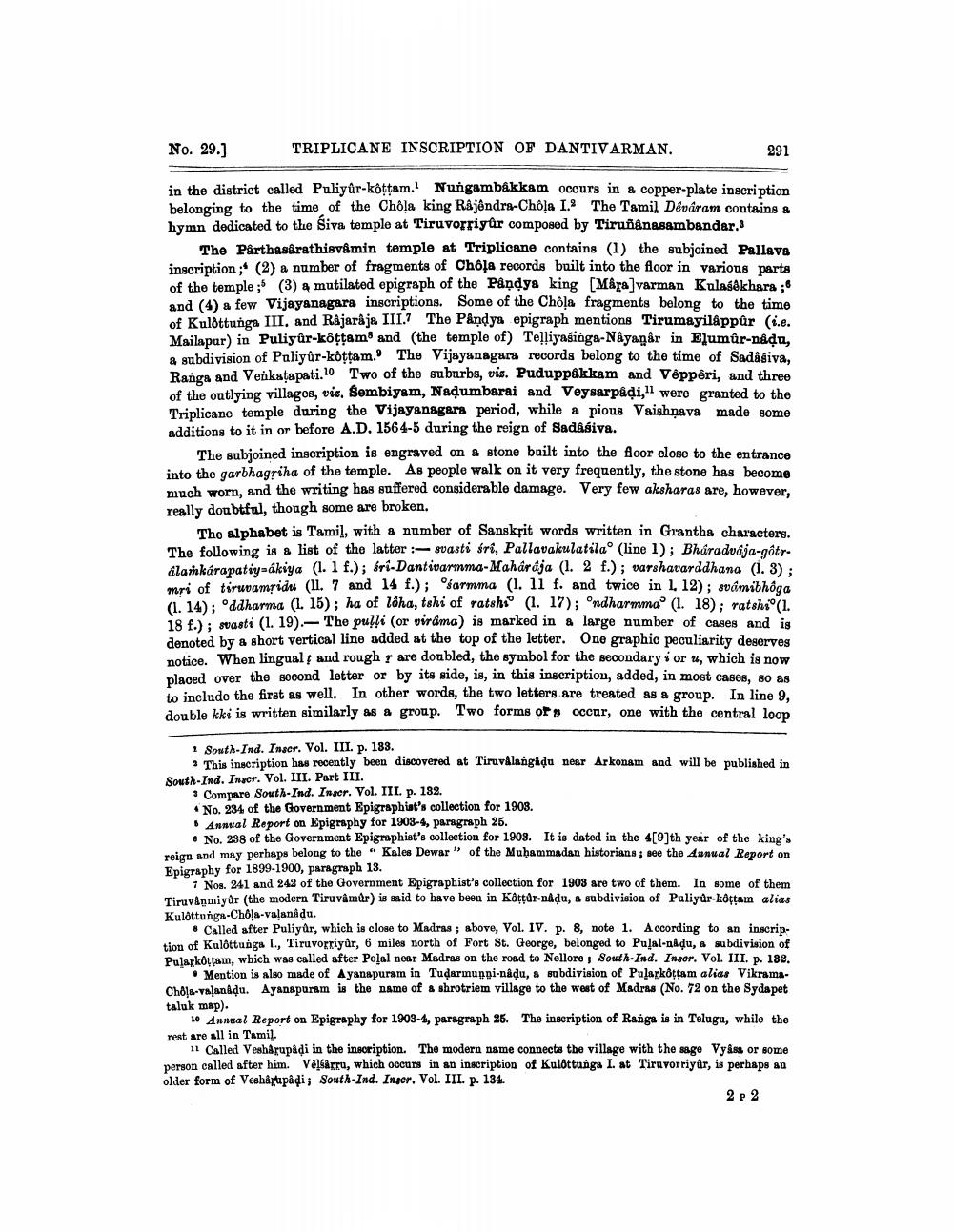________________
No. 29.]
TRIPLICANE INSCRIPTION OF DANTIVARMAN.
291
in the district called Puliyûr-kottam. Nungambakkam occurs in & copper-plate inscription belonging to the time of the Chola king Rajendra-Chô!a 1.The Tamil Déváram contains a hymn dedicated to the Siva temple at Tiruvorrigûr composed by Tiruñánasambandar.
The Parthagirathisvâmin temple at Triplicane contains (1) the subjoined Pallava inscription" (2) a number of fragments of Chôļa records built into the floor in various parts of the temple (3) A mutilated epigraph of the Påndya king [Måra]varman Kulasekhara ;8 and (4) a few Vijayanagara inscriptions. Some of the Chola fragments belong to the time of Kulottunga III, and Rajaraja III.7 The Påndys epigraph mentions Tirumayil&ppur (i.e. Mailapar) in Puliyûr-kottam and the temple of) Telliyasinga-Nayanar in Elumûr-nadu, a snbdivision of Puliyûr-kottam." The Vijayanagara records belong to the time of Sadasiva. Ranga and Venkatapati.10 Two of the suburbs, viz. Puduppakkam and Vêppéri, and three of the outlying villages, vis, Sembiyam, Nadumbarai and Veysarpadi," were granted to the Triplicane temple during the Vijayanagara period, while a pious Vaishnava made some additions to it in or before A.D. 1564-5 during the reign of Sadasiva.
The ambioined inscription is engraved on a stone built into the floor close to the entrance into the garbhagriha of the temple. As people walk on it very frequently, the stone has become much worn, and the writing has suffered considerable damage. Very few aksharas are, however, really doubtful, though some are broken.
The alphabet is Tamil, with a number of Sanskrit words written in Grantha characters. The following is a list of the latter :-svasta sri, Pallavakulatila (line 1); Bhuradvája-côtralankárapatiydkiya (1. 1 f.); Sri-Dantivarmma-Maharaja (1.2 f.); varshavarddhana (1.3): mri of tiruvamridu (II. 7 and 14 f.); sarmma (1. 11 f. and twice in 1, 12); svámibhôga a. 14): adharma (1. 15); ha of lâha, tshi of ratshi" (1. 17); Ondharmma' (1. 18); ratshi°(1. 1st.) wasti (1. 19). The pulli (or viráma) is marked in a large number of cases and is denoted by a short vertical line added at the top of the letter. One graphic peculiarity deserves notice. When lingual and rough r are doubled, the symbol for the secondary i or 1, which is now placed over the second letter or by its side, is, in this inscription, added, in most cases, 80 as to include the first as well. In other words, the two letters are treated as a group. In line 9, double kki is written similarly as a group. Two forms of occar, one with the central loop
1 South-Ind. Inscr. Vol. III. p. 183.
3 This inscription has recently been discovered at TiruvAlangkļu near Arkonam and will be published in South-Ind. Inser. Vol. III. Part III.
* Compare South-Ind. Inscr. Vol. III. p. 182. No. 234 of the Government Epigraphiat's collection for 1908.
Annual Report on Epigraphy for 1903-4, paragraph 25.
• No. 238 of the Government Epigraphist's collection for 1908. It is dated in the 4[9]th year of the king's reign and may perhaps belong to the "Kales Dewar" of the Muhammadan historians, see the Annual Report on Epigraphy for 1899-1900, paragraph 13.
Nos. 241 and 242 of the Government Epigraphist's collection for 1908 are two of them. In some of them Tiruvanmiyur (the modern Tiruvêmur) is said to have been in Köçdr-nadu, & subdivision of Puliyur-kõttam alias Kulottunga-Choa-valandu.
• Called after Puliyûr, which is close to Madras ; above, Vol. IV. p. 8, note 1. According to an inscription of Kulottunga I., Tiruvorriyūr, 6 miles north of Fort St. George, belonged to Pulal-nadu, & subdivision of Pularkáttam, which was called after Polal near Madras on the road to Nellore ; South-Ind. Inger. Vol. III. p. 132.
Mention is also made of Ayanapuram in Tudarmungi-nadu, a subdivision of Pularkottam alias VikramaChôļa-valandu. Ayanapuram is the name of a shrotriem village to the west of Madras (No. 72 on the Sydapet taluk map).
10 Annual Report on Epigraphy for 1903-4, paragraph 26. The inscription of Ranga is in Telugu, while the rest are all in Tamil.
11 Called Vesharupadi in the inscription. The modern name connects the village with the sage Vyåss or some person called after him. Vélsárry, which occurs in an inscription of Kulottunga I. at Tiruvorriyor, is perhaps an older form of Veshårtapadi; South-Ind. Inger. Vol. III. p. 134.
2 p 2




